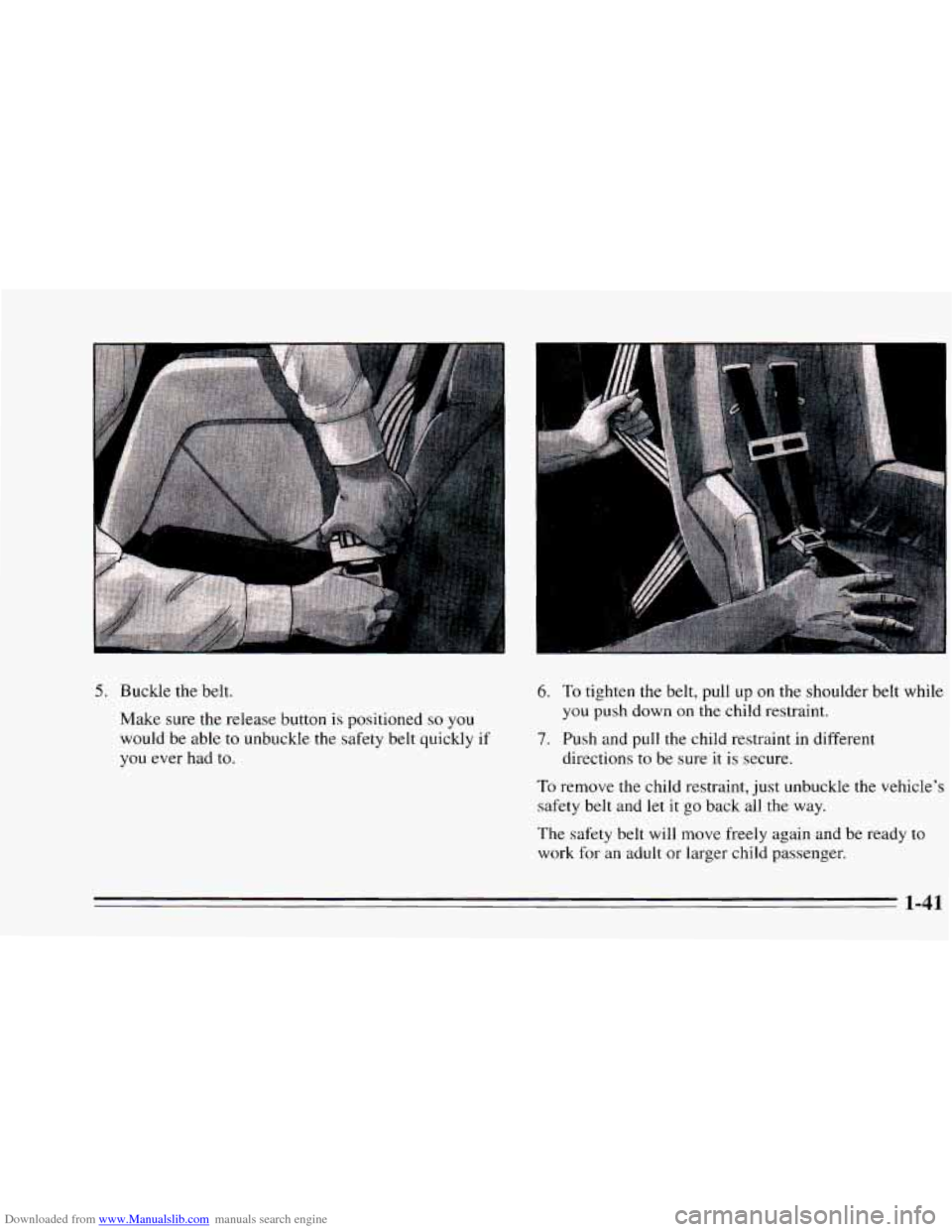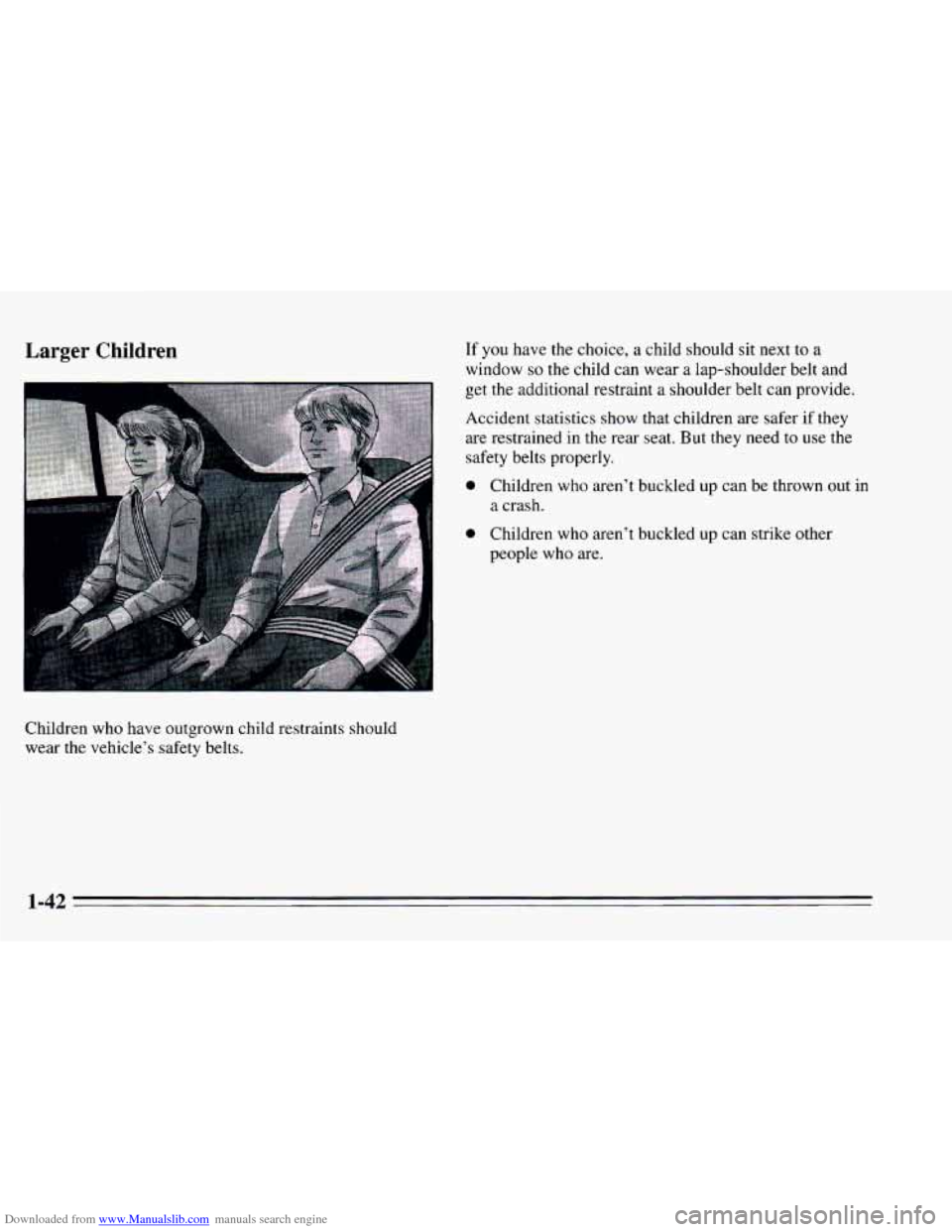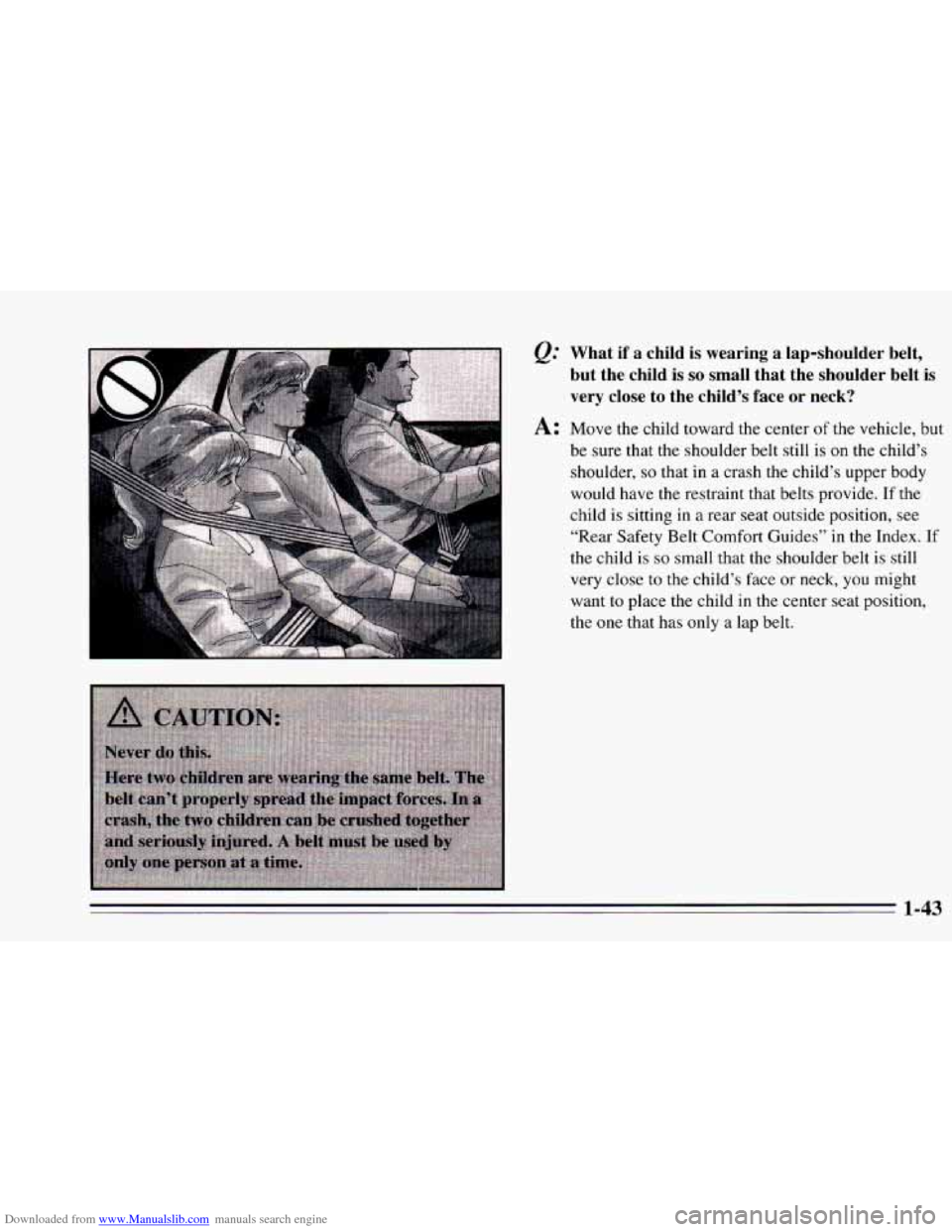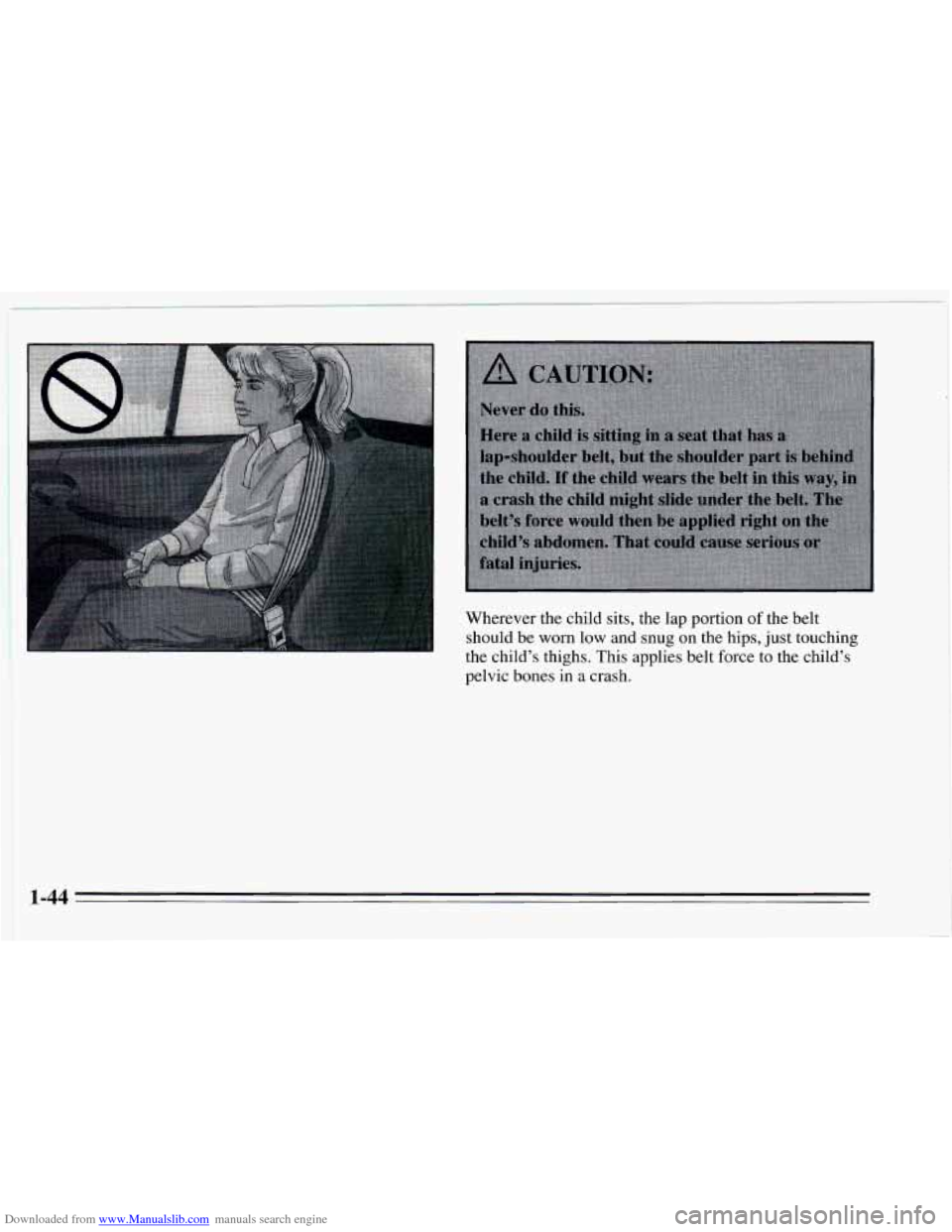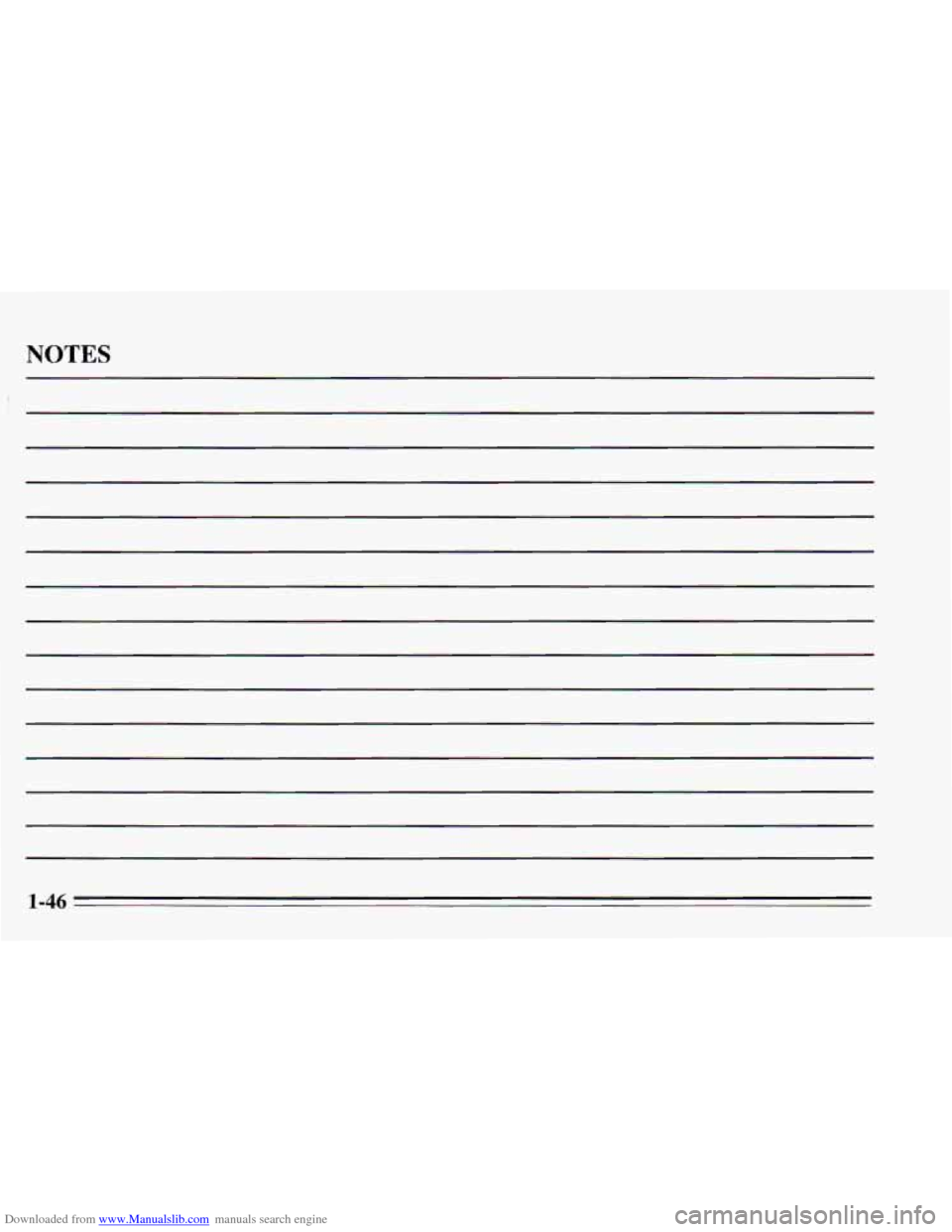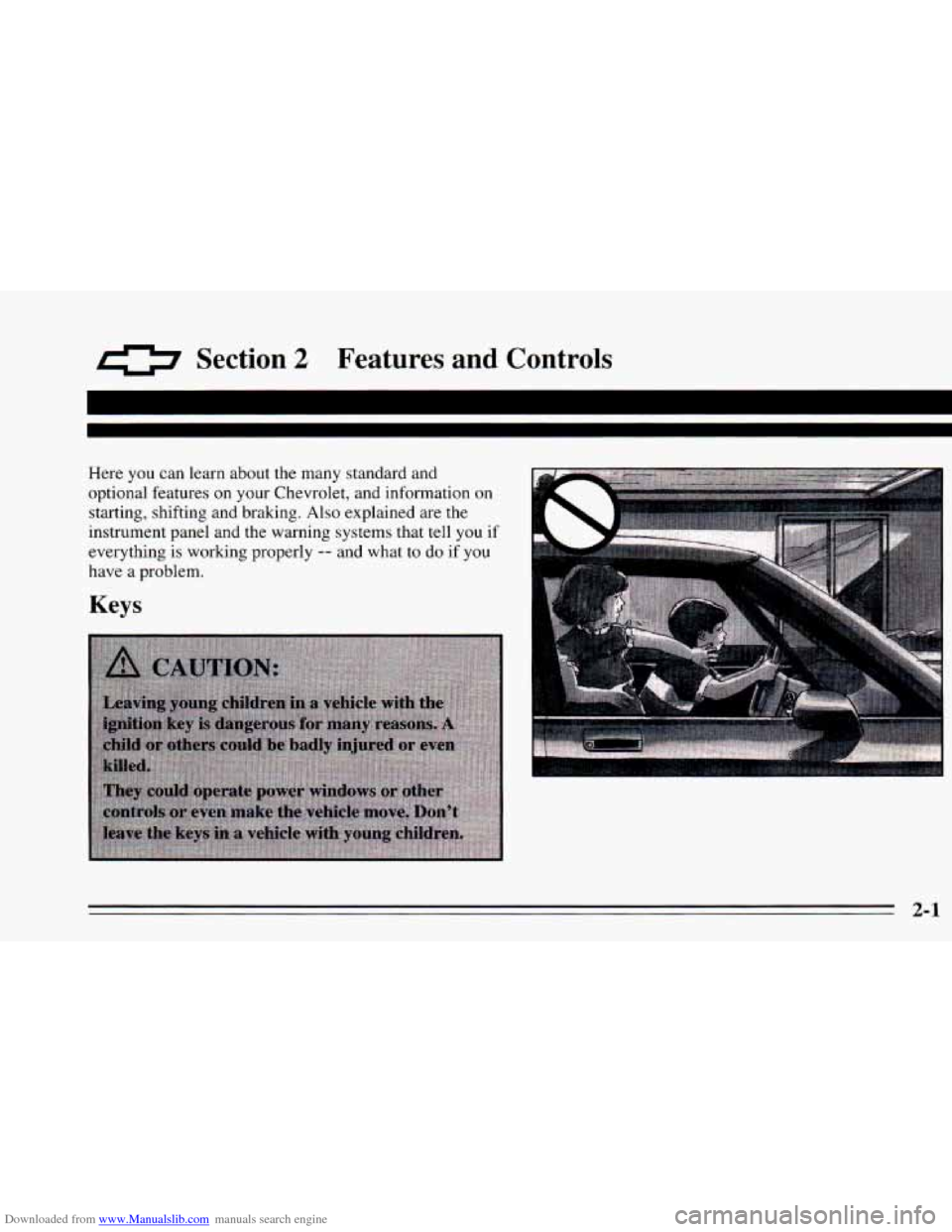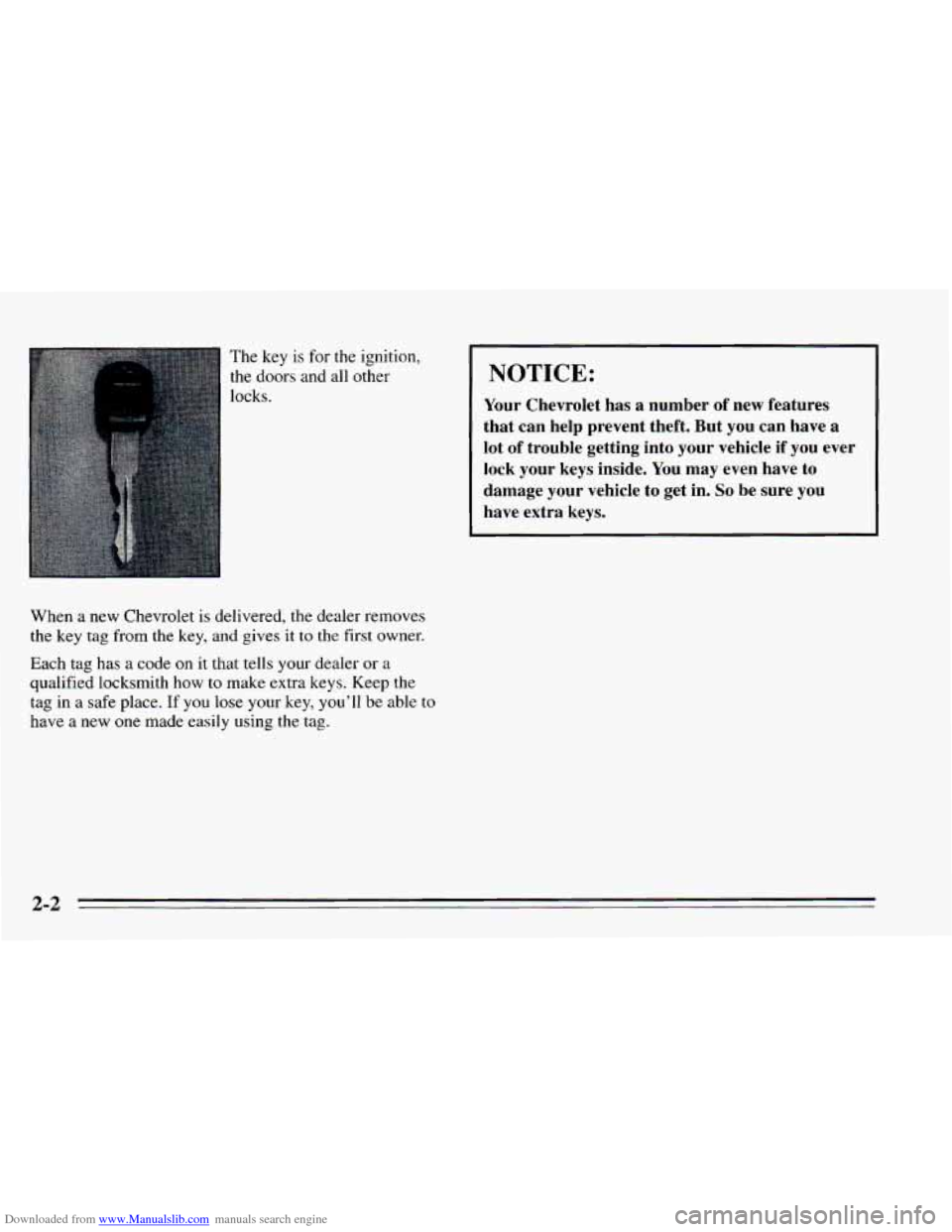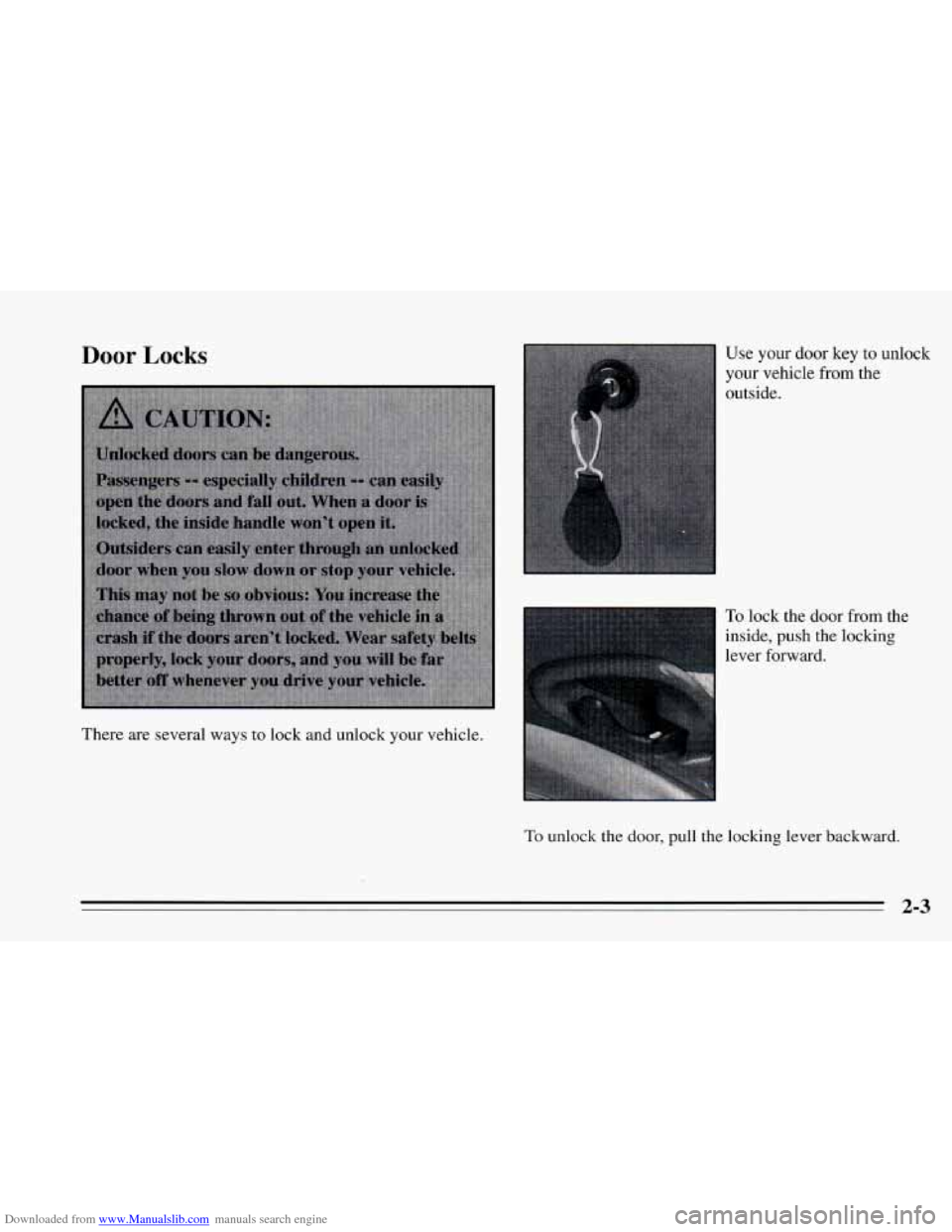CHEVROLET CAVALIER 1995 3.G Workshop Manual
CAVALIER 1995 3.G
CHEVROLET
CHEVROLET
https://www.carmanualsonline.info/img/24/8079/w960_8079-0.png
CHEVROLET CAVALIER 1995 3.G Workshop Manual
Trending: steering wheel adjustment, fuel pressure, service interval, fuel reserve, length, oil filter, window
Page 51 of 340
Downloaded from www.Manualslib.com manuals search engine 5. Buckle the belt.
Make sure the release button is positioned
so you
would be able to unbuckle the safety belt quickly if
you ever had to.
6. To tighten the belt, pull up on the shoulder belt while
you push down on the child restraint.
7. Push and pull the child restraint in different
To remove the child restraint, just unbuckle the vehicle’s
safety belt and let
it go back all the way.
directions to
be sure it is secure.
The safety belt
will move freely again and be ready to
work for an adult or larger child passenger.
1-41
Page 52 of 340
Downloaded from www.Manualslib.com manuals search engine Larger Children If you have the choice, a child should sit next to a
window
so the child can wear a lap-shoulder belt and
get the additional restraint a shoulder belt can provide.
Accident statistics show that children
are safer if they
are restrained in the rear seat. But they need
to use the
safety belts properly.
0 Children who aren’t buckled up can be thrown out in
0 Children who aren’t buckled up can strike other
a crash.
people who are.
Children who have outgrown child restraints should
wear the vehicle’s safety belts.
1-42
Page 53 of 340
Downloaded from www.Manualslib.com manuals search engine . , . , , . ..
&= What if a child is wearing a lap-shoulder belt,
but the child
is so small that the shoulder belt is
very close to the child’s face or neck?
A: Move the child toward the center of the vehicle, but
be sure that the shoulder belt still is
on the child’s
shoulder,
so that in a crash the child’s upper body
would have the restraint that belts provide.
If the
child
is sitting in a rear seat outside position, see
“Rear Safety Belt Comfort Guides” in the Index.
If
the child is so small that the shoulder belt is still
very close to the child’s face or neck, you might
want
to place the child in the center seat position,
the one that has only a lap belt.
1-43
Page 54 of 340
Downloaded from www.Manualslib.com manuals search engine Wherever the child sits, the lap portion of the belt
should
be worn low and snug on the hips, just touching
the child’s thighs. This applies belt force to the child’s
pelvic bones in
a crash.
1-44
Page 55 of 340
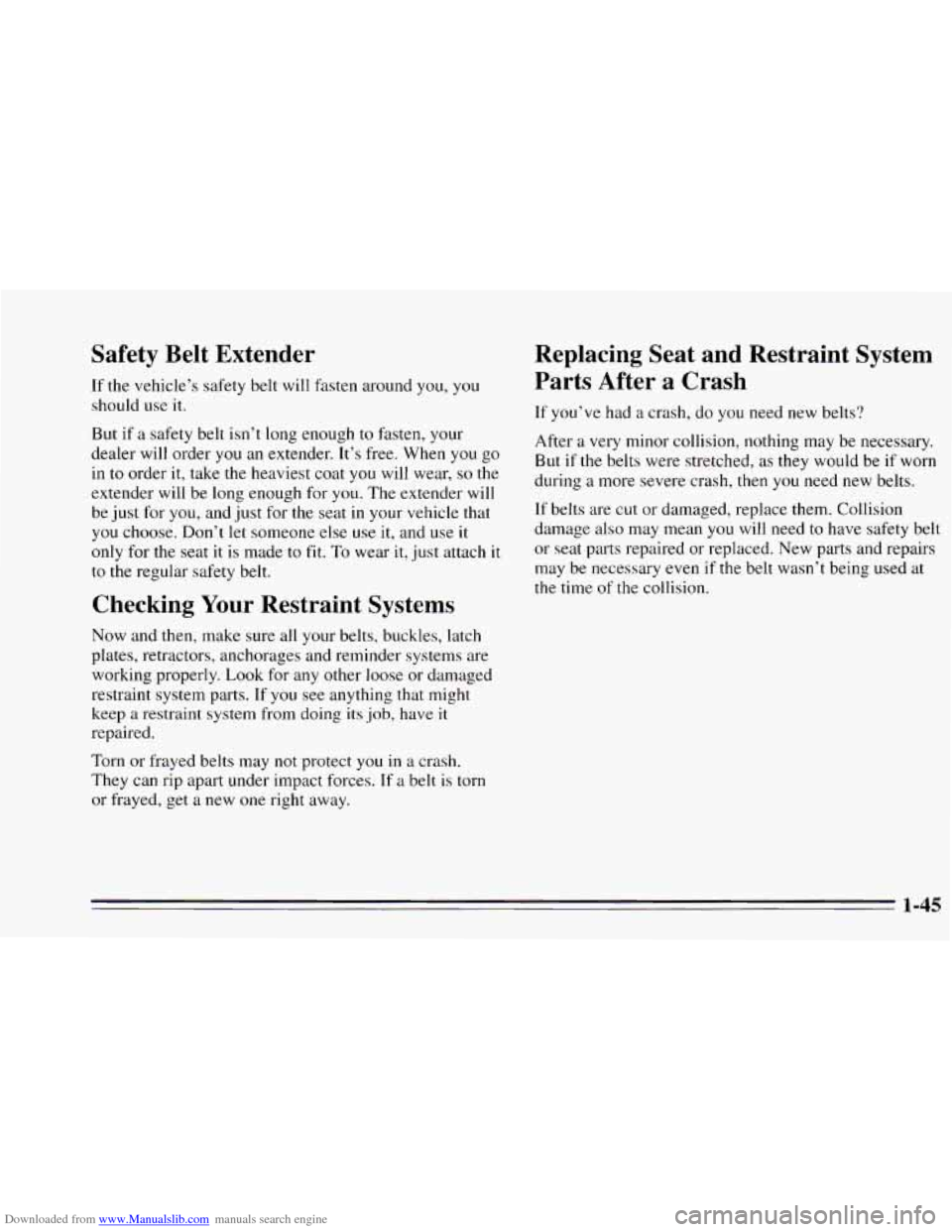
Downloaded from www.Manualslib.com manuals search engine Safety Belt Extender
If the vehicle’s safety belt will fasten around you, you
should use
it.
But if a safety belt isn’t long enough to fasten, your
dealer will order
you an extender. It’s free. When you go
in to order it, take the heaviest coat you will wear, so the
extender will be long enough for you. The extender will
be just for
you, and just for the seat in your vehicle that
you choose. Don’t let someone else use it, and use it
only for the seat it
is made to fit. To wear it, just attach it
to the regular safety belt.
Checking Your Restraint Systems
Now and then, make sure all your belts, buckles, latch
plates, retractors, anchorages and reminder systems are
working properly. Look for any other loose or damaged
restraint system parts. If you see anything that might
keep
a restraint system from doing its job, have it
repaired.
Torn or frayed belts may not protect you
in a crash.
They can rip apart under impact forces.
If a belt is torn
or frayed, get a new one right away.
Replacing Seat and Restraint System
Parts After a Crash
If you’ve had a crash, do you need new belts?
After a very minor collision, nothing may be necessary.
But if the belts were stretched, as they would be if worn
during a more severe crash, then
you need new belts.
If belts are cut or damaged, replace them. Collision
damage also may mean you will need to have safety belt
or seat parts repaired or replaced. New parts and repairs
may be necessary even
if the belt wasn’t being used at
the time of the collision.
1-45
Page 56 of 340
Downloaded from www.Manualslib.com manuals search engine NOTES
1-46
Page 57 of 340
Downloaded from www.Manualslib.com manuals search engine 0 Section 2 Features and Controls
Here you can learn about the many standard and
optional features on your Chevrolet, and information on
starting, shifting and braking.
Also explained are the
instrument panel and the warning systems that tell you
if
everything is working properly -- and what to do if you
have a problem.
Keys
Page 58 of 340
Downloaded from www.Manualslib.com manuals search engine The key is for the ignition,
the
doors and all other
locks.
When a new Chevrolet
is delivered, the dealer removes
the key tag from the key, and gives it
to the first owner.
Each tag has a code
on it that tells your dealer or a
qualified locksmith how to make extra keys. Keep the
tag in a safe place.
If you lose your key, you’ll be able to
have a new one made easily using the tag.
I NOTICE:
Your Chevrolet has a number of new features
that can help prevent theft. But you can have a
lot of trouble getting into your vehicle if you ever
lock your keys inside.
You may even have to
damage your vehicle to get in.
So be sure you
have extra keys.
2-2
Page 59 of 340
Downloaded from www.Manualslib.com manuals search engine Door Locks
There are several ways to lock and unlock your vehicle. Use your door
key to unlock
your vehicle from the
outside.
To lock the door from the
inside, push the locking
lever forward.
To unlock the door, pull the locking lever backward.
Page 60 of 340
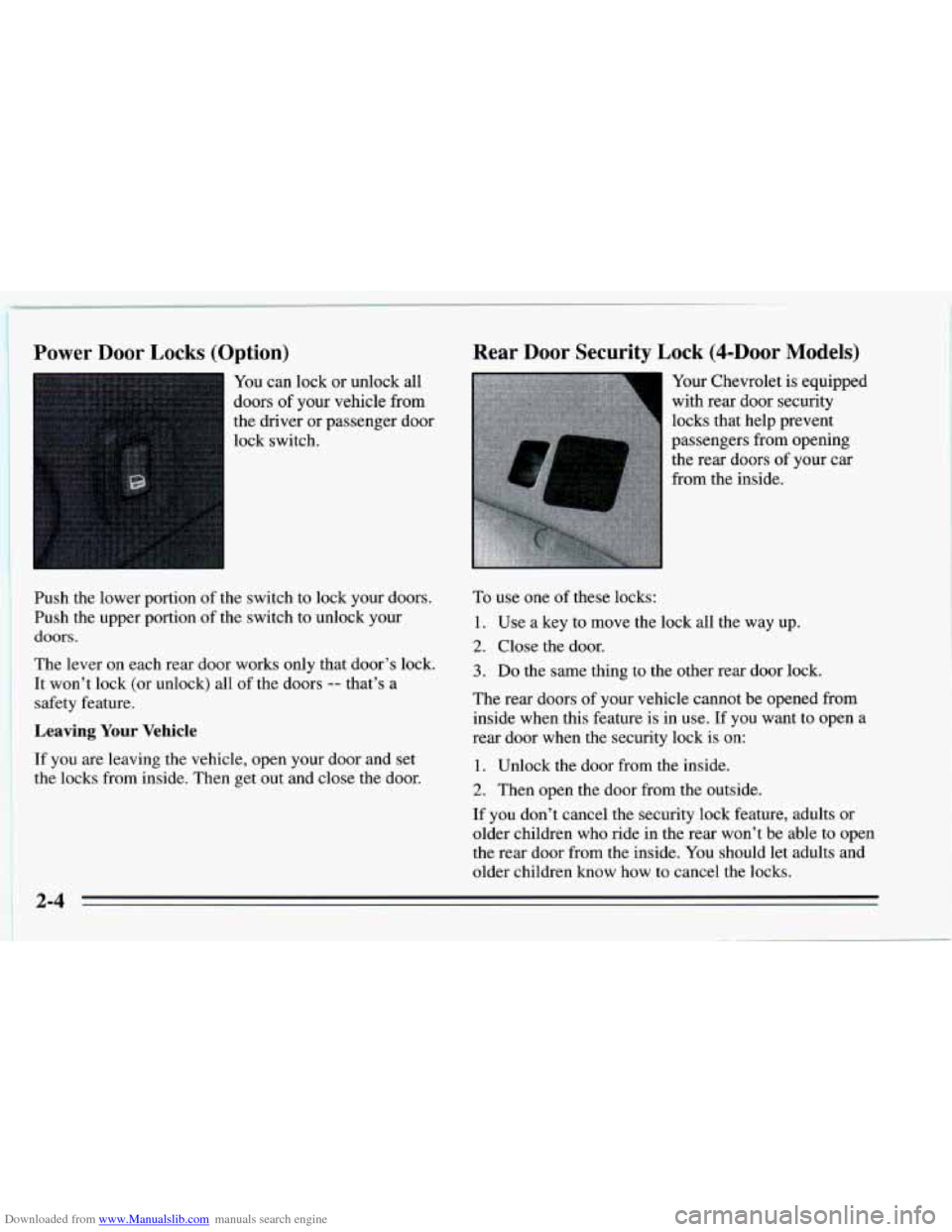
Downloaded from www.Manualslib.com manuals search engine 1 Power Door Locks (Option) ~
You can lock or unlock all
doors
of your vehicle from
the driver or passenger door
lock switch.
Push the lower portion of the switch to lock your doors.
Push the upper portion of the switch to unlock your
doors.
The lever on each rear door works only that door’s lock.
It won’t lock (or unlock) all of the doors
-- that’s a
safety feature.
Leaving Your Vehicle
If you are leaving the vehicle, open your door and set
the locks from inside. Then get out and close the door.
Rear Door Security Lock (4-DOOr Models)
Your Chevrolet is equipped
with rear door security
locks that help prevent
passengers from opening the rear doors
of your car
from the inside.
To use one of these locks:
1. Use a key to move the lock all the way up.
2. Close the door.
3. Do the same thing to the other rear door lock.
The rear doors of your vehicle cannot be opened from
inside when this feature is in use. If you want to open a
rear door when the security lock
is on:
1. Unlock the door from the inside.
2. Then open the door from the outside.
If you don’t cancel the security lock feature, adults or
older children who ride in the rear won’t be able to open
the rear door from the inside. You should let adults and
older children know
how to cancel the locks.
Trending: coolant temperature, fuel pump, length, ESP, trunk release, width, check engine
